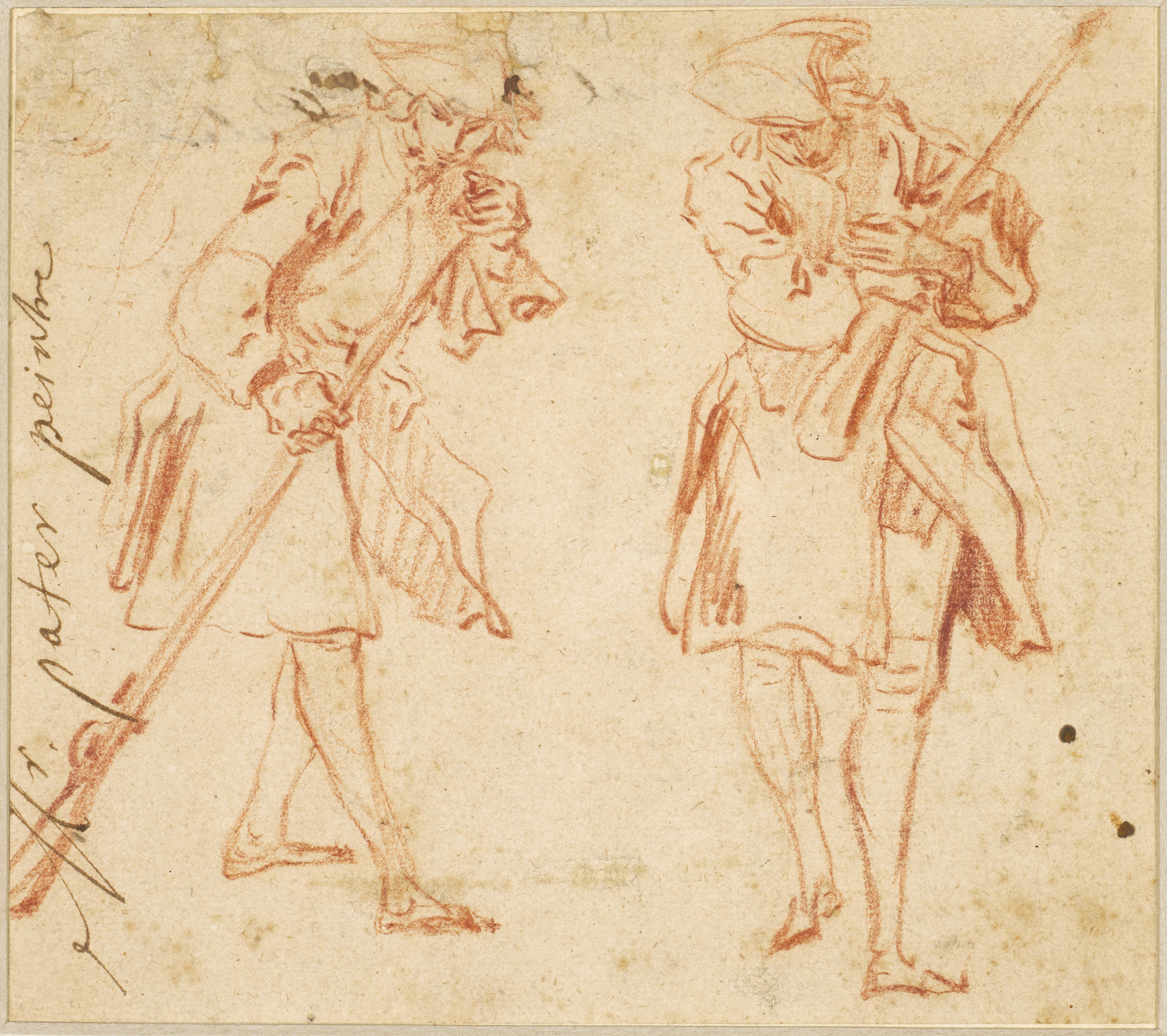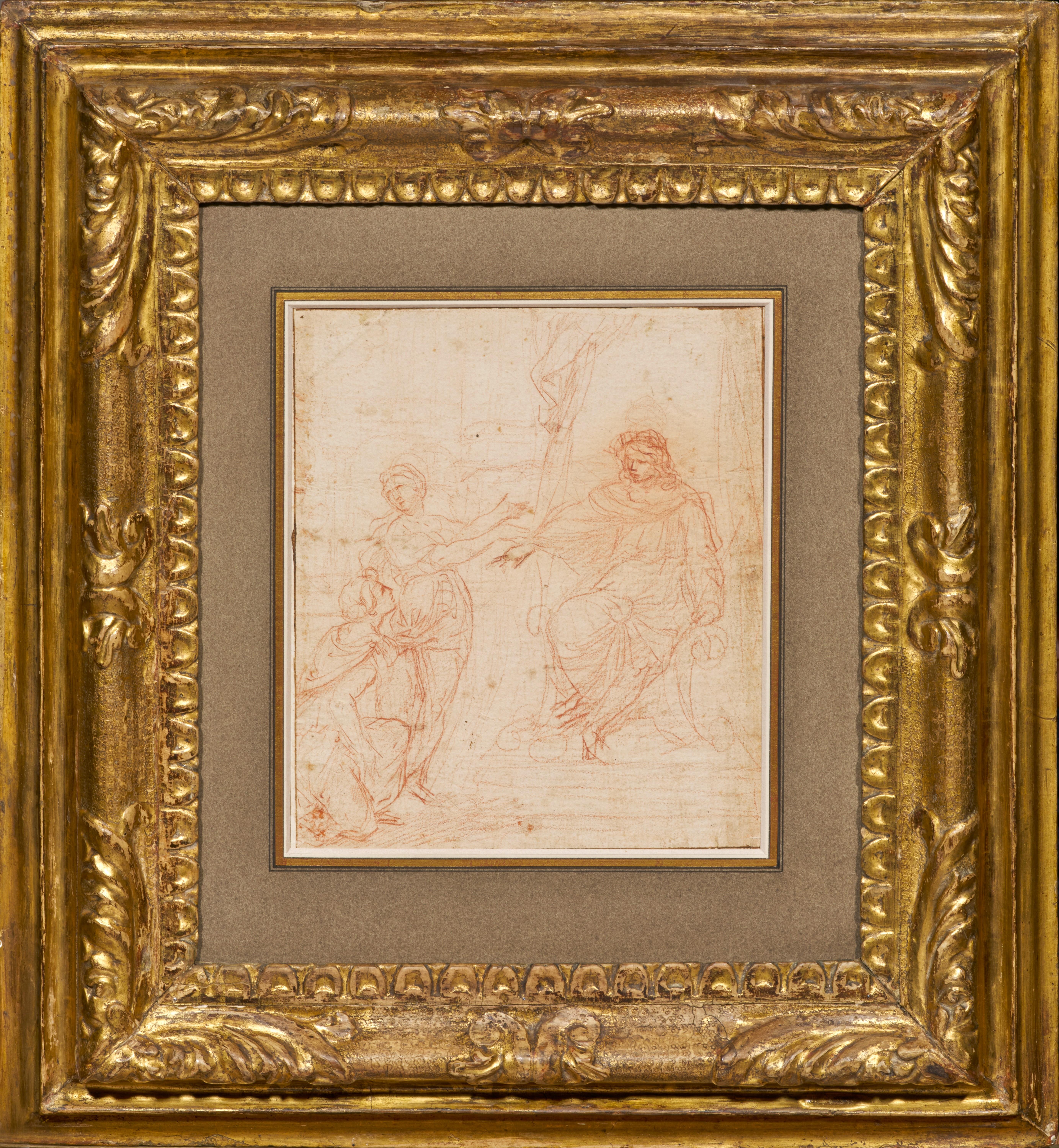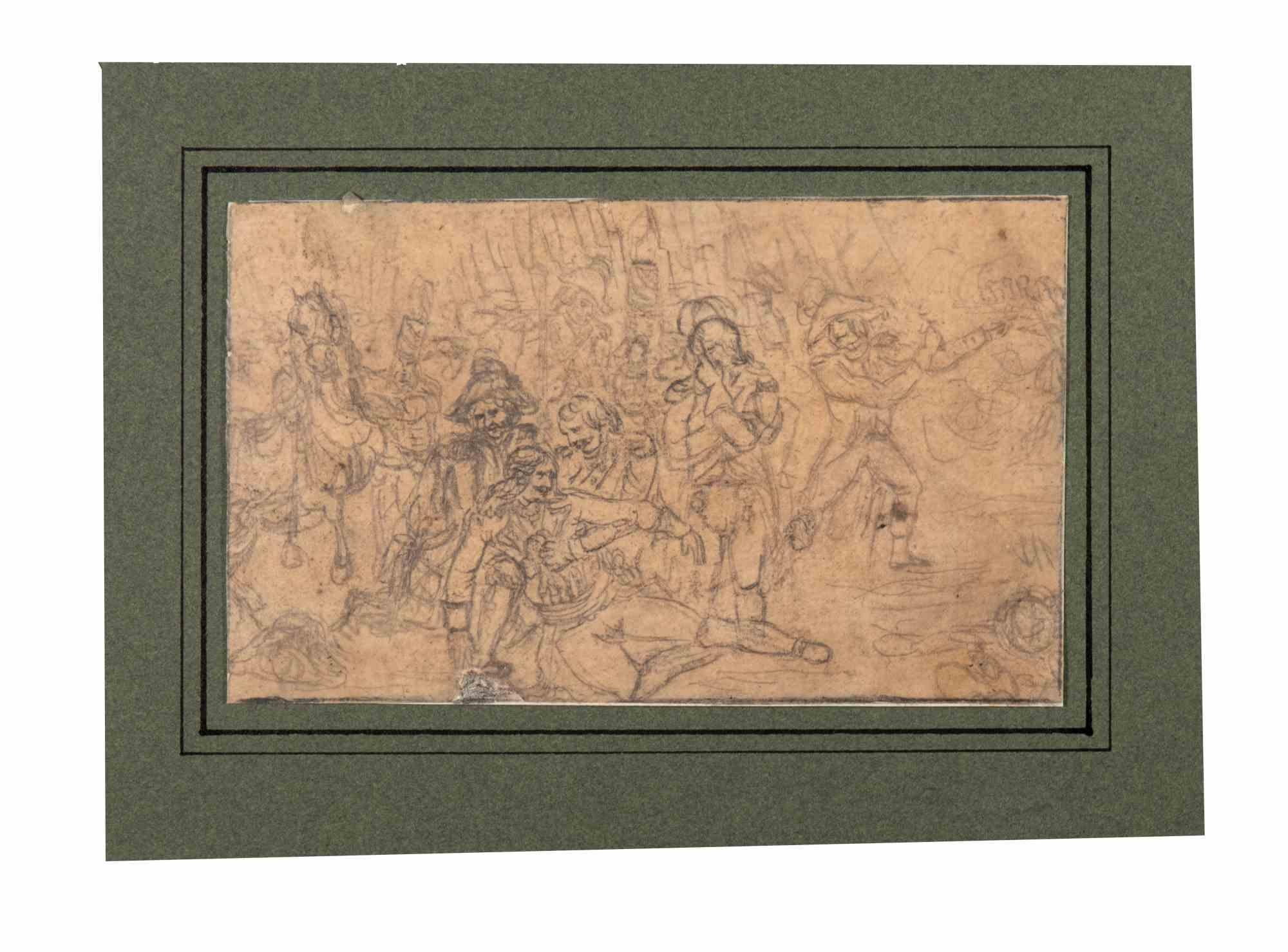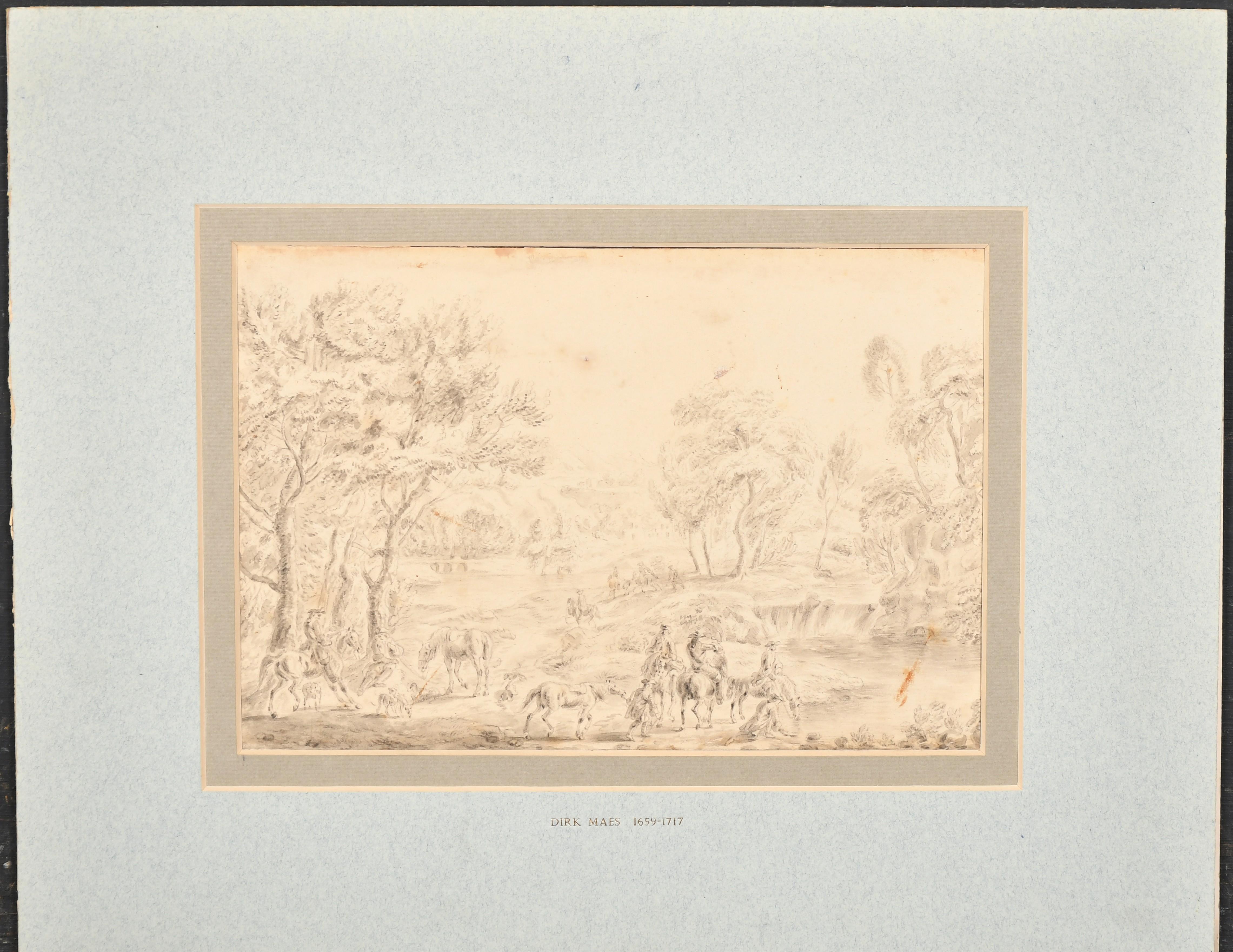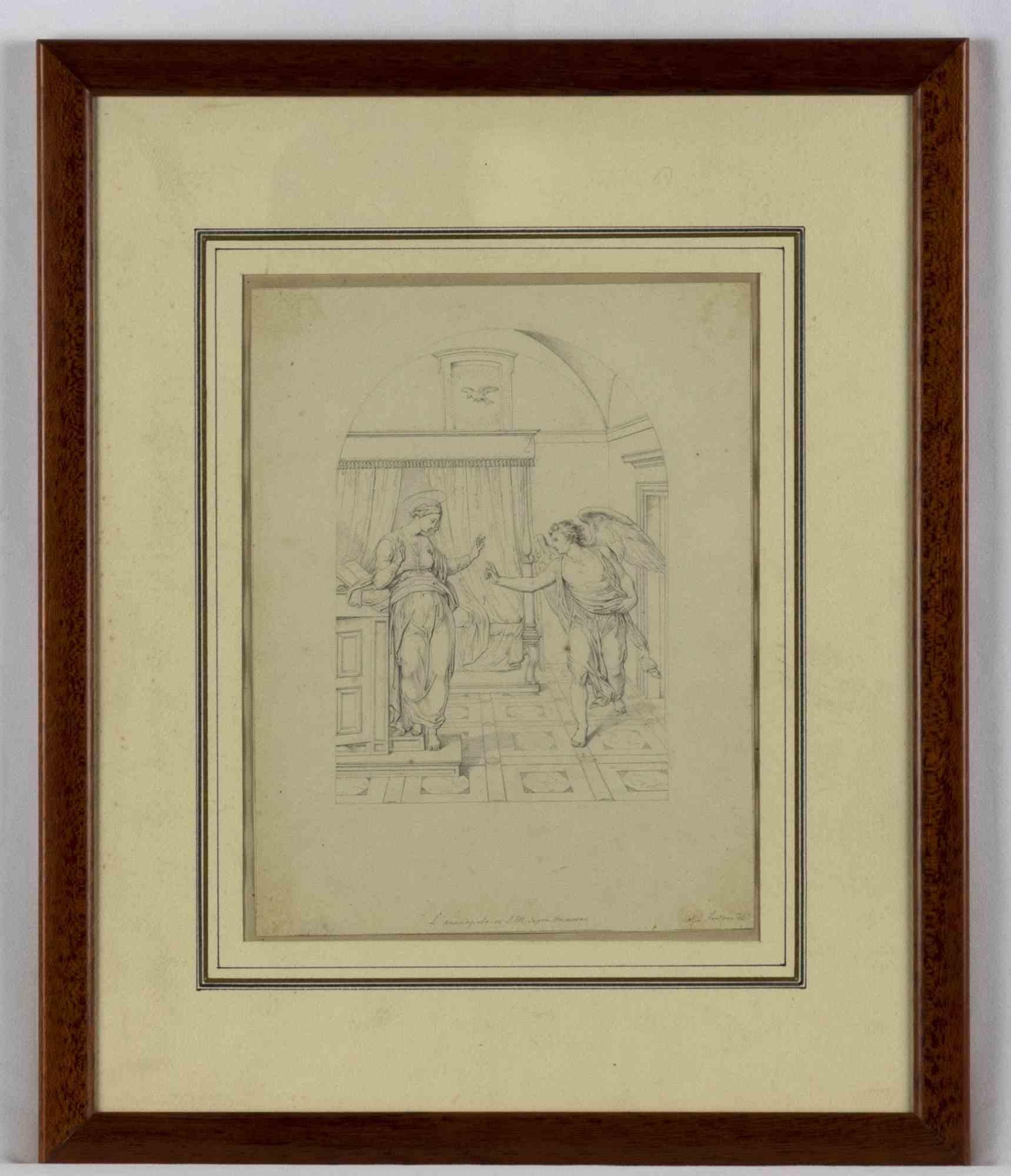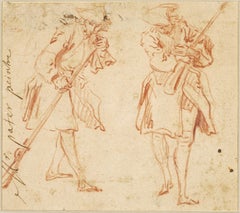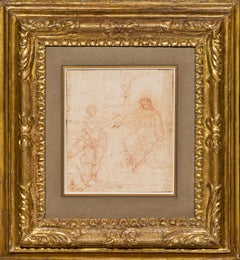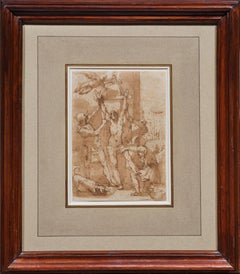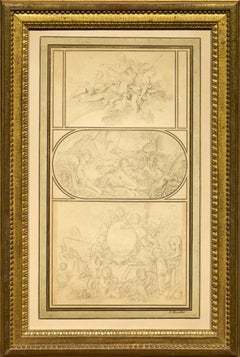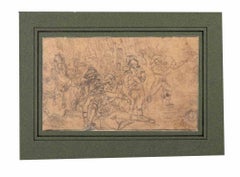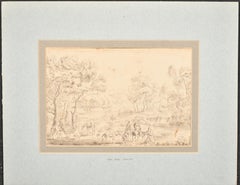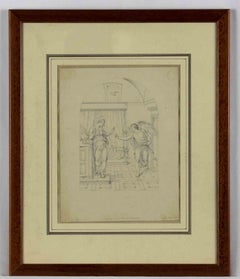Items Similar to Study for a Hunting Scene, a red chalk sketch attributed to Karel du Jardin
Want more images or videos?
Request additional images or videos from the seller
1 of 13
Study for a Hunting Scene, a red chalk sketch attributed to Karel du Jardin1657-1658
1657-1658
$16,020.85
£11,962.11
€13,500
CA$22,508.99
A$24,627.84
CHF 12,707.90
MX$294,915.77
NOK 161,332.77
SEK 151,153.25
DKK 102,833.35
About the Item
We would like to thank Carolina Trupiano Kowalczyk for suggesting this attribution to Karel du Jardin after direct examination of the artwork. Her study of the drawing (in Italian), on which this presentation is based, is available on request.
This study of hunters is intriguing not only for its subject matter (a young man bringing the foot of an animal as a trophy to a hunter busy reloading his rifle) but also for its technique: a barely sketched red chalk drawing, probably preparatory to a work in ink wash, a project that was never realized, as evidenced only by the gray highlight on the hunter's hat.
A comparison with several works by Karel du Jardin, particularly a red chalk study of a man held by the Fogg Art Museum, leads us to attribute this work to that artist (whose drawings are quite rare on the market and in public collections) and to date it to around 1657-1658, a period during which the artist was living in The Hague.
1. Karel du Jardin, an artist from the Netherlands influenced by the Bamboccianti
Born in Amsterdam into a modest family, Karel du Jardin began his training in his native country, as Arnold Houbraken writes . He was the most gifted pupil of Nicolaes Berchem (Haarlem 1620 - Amsterdam 1683). Du Jardin followed the tradition established by Berchem, using red chalk for most of his studies of characters and animals, but softening the lines while retaining their incisive and rapid character. In his genre scenes, Du Jardin combined Flemish teaching with the influence of the "Bamboccianti," the northern painters active in 17th-century Rome, whose precursor was Pieter Bodding van Laer (Haarlem, c. 1599 - c. 1641), known as Il Bamboccio.
Settling in Rome in 1625, Van Laer became a central figure among the Dutch and Flemish painters of the Bentvueghels . His painting is characterized by realistic and sometimes caricatural representations of everyday life in Rome, with scenes of brigands, travelers, markets, and hunters, often in small format, within the city walls or in the countryside. The success of Du Jardin's work lies precisely in his choice to depict Italianate landscapes, combining them with picturesque characters, travelers, and shepherds, often represented in a grotesque manner, in the style of Van Laer.
Very little information is available about Du Jardin before 1649, when he left for Lyon and married his landlady, Suzanne van Royen, in Paris in December of the same year, perhaps to clear his debts. At that time, he lived between Amsterdam and Paris, where he had the opportunity to study the work of French artists. In October 1656, Du Jardin was active in The Hague, where he was one of the founding members of the Pictura artists' guild. In 1659, he returned to Amsterdam, where he began a period of success and renown. He was commissioned to paint portraits of the Dutch aristocratic and merchant elite as well as spectacular historical scenes, becoming one of the most popular and highest-paid artists of his time.
The reasons for his departure for Italy in 1675 are unknown, perhaps in order to follow his friend Johann Reynst, or out of a desire to find new clients more interested in historical subjects. In Rome, he frequented the Bentvueghels group, where he was given the nickname Barba di Becco or "Bokkebaart." This period had a lasting influence on his work, which now included depictions of idealized landscapes of the Roman countryside, with their vast horizons and characters constructed with light, the result of meticulous research into chiaroscuro, as can be seen in his first Roman painting Travelers in an Italian Landscape, (Antwerp, Koninklijk Museum voor Schone Kunsten - 6th photo in the gallery), dated "fecit Roma 1675," and in his lively genre scenes depicting everyday life in the City.
After a stopover in Tangier, North Africa, he arrived in Venice in 1678. He fell seriously ill and was buried on October 9 of the same year.
2. Description of the drawing and related artworks
The drawing depicts a hunter kneeling down to load his rifle, while a young boy approaches him and timidly hands him the trophy of the hunt: the foot of the animal he has shot. The scene, depicted on a small sheet of paper, could be a preliminary study for a larger painting or print representing a larger and more complex hunting scene, executed in the Dutch figurative tradition of the mid-17th century.
Two figures in a similar pose appear in the print Landscape with Ruins, Two Men and a Dog by Du Jardin (1658 - 7th photo in the gallery), in which they are depicted from a distance and stripped of their hunting attributes, in an idyllic landscape dotted with ruins.
Our hunter also bears a strong resemblance in his posture to the Seated Man removing his Boots in the Fogg Art Museum (circa 1657 - 8th photo in the gallery). This seated man and our hunter, both carefully depicted, have the same expressiveness: they are shown in profile, with a wide hat casting a shadow over their faces, leaning toward the ground, left shoulder forward, in the Fogg drawing to remove his boot, in our drawing to hold his rifle.
In the Fogg Museum drawing, the red chalk is densely stumped to create deep shadows and light effects. In our drawing, it only defines the contours of the figures, which are sketched in a very expressive manner, but without any contextual elements (rocks, cast shadows, etc.). All this leads us to believe that we have here a red chalk sketch . The presence of a touch of gray wash on the hunter's hat gives us an additional clue: this sketch was probably intended to be completed with gray ink wash. The Metropolitan Museum's sheet (9th photo in the gallery), Peasant Woman and Donkey crossing a Stream, provides a good illustration of Karel du Jardin's use of this technique: the gray is skillfully nuanced and enhanced by brown ink outlines on a preparatory sketch in red chalk.
While Du Jardin's painted and engraved work is significant, few of the studies and sketches on paper that he made for his compositions have survived. Most are animal studies, while studies of characters are very rare in the artist's corpus preserved or known to date.
3. Framing
Our drawing is presented in a period Louis XIII frame in carved and gilded wood decorated with foliage and scrollwork, which has largely retained its original gilding.
- Attributed to:Karel du Jardin (1626 - 1678, Dutch)
- Creation Year:1657-1658
- Dimensions:Height: 12.63 in (32.09 cm)Width: 15.5 in (39.37 cm)
- Medium:
- Movement & Style:
- Period:1650-1659
- Condition:Red chalk, brush and gray ink wash Dimensions : 5 3/4’’ x 7 5/8’’ (145 x 195 mm) – Framed : 12 5/8’’ x 15 ½’’ (32 x 39.5 cm) Period Louis XIII frame in carved and gilded wood decorated with foliage and scrollwork.
- Gallery Location:PARIS, FR
- Reference Number:1stDibs: LU1568216852752
About the Seller
5.0
Vetted Professional Seller
Every seller passes strict standards for authenticity and reliability
Established in 2020
1stDibs seller since 2021
10 sales on 1stDibs
- ShippingRetrieving quote...Shipping from: PARIS, France
- Return Policy
Authenticity Guarantee
In the unlikely event there’s an issue with an item’s authenticity, contact us within 1 year for a full refund. DetailsMoney-Back Guarantee
If your item is not as described, is damaged in transit, or does not arrive, contact us within 7 days for a full refund. Details24-Hour Cancellation
You have a 24-hour grace period in which to reconsider your purchase, with no questions asked.Vetted Professional Sellers
Our world-class sellers must adhere to strict standards for service and quality, maintaining the integrity of our listings.Price-Match Guarantee
If you find that a seller listed the same item for a lower price elsewhere, we’ll match it.Trusted Global Delivery
Our best-in-class carrier network provides specialized shipping options worldwide, including custom delivery.More From This Seller
View AllTwo military studies, a preparatory red chalk drawing by Jean-Baptiste Pater
By Jean-Baptiste Pater
Located in PARIS, FR
As Florence Ingersoll-Smouse wrote in 1921 in her book devoted to Jean-Baptiste Pater, "a painter of the Fête galante, Pater is interesting both by his intimacy with Watteau, to whom many of his works are still attributed, and by his own value as an artist.” This sanguine, full of life and spontaneity, is typical of the preparatory studies made by the painter to be used later in the composition of his paintings.
1. Jean-Baptiste Pater, pupil and disciple of Antoine Watteau
Antoine Pater, Jean-Baptiste's father, belonged to the petty bourgeoisie of Valenciennes where he worked as a merchant-sculptor. His brother Jacques was a local painter who was probably involved in his nephew's training. Born on December 29, 1695, Jean-Baptiste Pater was first trained with Jean-Baptiste Guider, a local painter whose death in 1711 was probably the reason for Jean-Baptiste’s departure alongside Watteau, who was visiting Valenciennes. Watteau's difficult character led to their separation in 1713.
Back in Valenciennes, Jean-Baptiste Pater encountered difficulties with the powerful Corporation of Saint-Luke (to which he refused to belong) which forced him to return to Paris in 1718. He reconciled with Watteau shortly before his death (on July 18th 1721), inherited the commissions that Watteau had been unable to fulfil and completed some of his paintings.
Pater was accepted by the Académie Royale in 1725 but did not produce his reception painting The soldier’s revels until three years later. Throughout his brief career (he died at the age of forty on July 25th 1736), he mainly had a clientele of amateurs and received only one royal commission, shortly before his death.
2. Description of the drawing and related artworks
Pater had adopted his master Watteau's method of composition. His study drawings were carefully glued in a notebook and were used to animate his compositions.
His paintings sometimes suffer from a somewhat artificial composition, since the figures seem to be pasted one next to the other. This point has also been made about Watteau’s.
The theme of military scenes (which was at the time included in the genre of Fêtes galantes!) was one of Pater’s favourite subjects. Together with the Bathing Women...
Category
1720s Old Masters Figurative Prints
Materials
Chalk
Studies for the Judgment of Solomon, a double-sided drawing by Simone Cantarini
Located in PARIS, FR
In this double-sided red chalk study, Simone Cantarini offers us a double reflection on the theme of the Judgment of Solomon. This sheet reveals his precise style and his sense of de...
Category
1640s Old Masters Figurative Drawings and Watercolors
Materials
Chalk, Laid Paper
The Martyrdom of Saint Bartholomew, a preparatory drawing by Alessandro Casolani
Located in PARIS, FR
This powerful pen and brown ink wash drawing is a study for an altarpiece depicting The Martyrdom of Saint Bartholomew. Signed and dated 1604, it was painted at the end of his life b...
Category
Early 1600s Old Masters Figurative Drawings and Watercolors
Materials
Ink, Pen
Three drawings by François Boucher in a mounting by Jean-Baptiste Glomy
By François Boucher
Located in PARIS, FR
We would like to thank Juliette Parmentier-Courreau of the Custodia Foundation for her welcome and support during the consultation of Glomy’s Journal des Ouvrages.
This spectacularly large "feuille de desseins ajustés" commissioned by François Boucher from Jean-Baptiste Glomy is emblematic of the painter's art and mastery of rocaille. It is also fully representative of the taste of this period in the field of decorative arts. The largest of these three drawings, placed at the bottom of the composition, is particularly interesting: dating from around 1756, it constitutes a modello (apparently unpublished) for the frontispiece of the "Catalogue des tableaux de Monsieur de Julienne"), preserved in the Morgan Library in New York.
1. François Boucher, the master of French rocaille
The extraordinary career of Francois Boucher was unmatched by his contemporaries in versatility, consistency and output. For many, particularly the writers and collectors who led the revival of interest in the French rococo during the last century, his sensuous beauties and plump cupids represent the French eighteenth century at its most typical. His facility with the brush, even when betraying the occasional superficiality of his art, enabled him to master every aspect of painting – history and mythology, portraiture, landscape, ordinary life and, as part of larger compositions, even still life. He had been trained as an engraver, and the skills of a draftsman, which he imbued in the studio of Jean-Francois Cars (1661 – 1738), stood him in good stead throughout his career; his delightful drawings are one of the most sought-after aspects of his oeuvre.
As a student of Francois Lemoyne (1688 - 1737), he mastered the art of composition. The four years he spent in Italy, from 1727-1731, educated him in the works of the masters, classics and history, that his modest upbringing had denied him.
On his return to Paris in 1734, he gained full membership of the Royal Academy of Painting and Sculpture with his splendid Rinaldo and Armida (Paris, Musée du Louvre). Although, throughout his career, he occasionally painted subjects taken from the Bible, and would always have considered himself first as a history painter, his own repertoire of heroines, seductresses, flirtatious peasant girls and erotic beauties was better suited to a lighter, more decorative subject matter. His mastery of technique and composition enabled him to move from large scale tapestry...
Category
1750s Old Masters Figurative Drawings and Watercolors
Materials
Chalk, Ink
From Renaissance Venice to Barocco Naples, a drawing by Francesco La Marra
Located in PARIS, FR
This vigorous drawing presents a brilliant synthesis between the Venetian tradition of Titian, of which it is a distant echo, and the Neapolitan Baroque of Solimena, which strongly i...
Category
Mid-18th Century Old Masters Figurative Drawings and Watercolors
Materials
Paper, Ink, Felt Pen
Study of a Fate at mid-body, a red chalk attributed to Giovanni da San Giovanni
Located in PARIS, FR
This spectacular red chalk drawing depicts an elderly woman, her eyes bulging, her hand stretched out towards the sky. This disturbing character, who seems close to dementia, and the elongation of her arm with its Mannerist overtones, plunge us into the Florentine artistic milieu of the first half of the 17th century. The proximity of this drawing to some characters in the fresco in the Pitti Palace representing The Muses, Poets and Philosophers chased from Parnassus, the last masterpiece of Giovanni da San Giovanni, leads us to propose an attribution to this artist and a dating of around 1635-1636.
1. Giovanni da San Giovanni, the painter of contradiction
We take here the title of the monography dedicated to the artist by Anna Banti in 1977, which remains the reference book for this artist. The son of a notary, Giovanni Mannozzi, known as Giovanni da San Giovanni, abandoned his studies to go to Florence at the age of sixteen, where he entered the studio of Matteo Rosselli (1578 - 1650) around 1609 and enrolled in the Academy of Drawing Arts in 1612. Around 1615 he produced his first known works, mainly frescoes for the city's tabernacles. He became famous in Florence for his originality, combining an obsessive application to the study of drawing and the reading of poetry and history with a disheveled appearance. Between 1619 and 1620 he decorated the facade of the Antella Palace in Piazza Santa Croce, a decoration that still partly survives today.
The death of Cosimo II in 1621 put an end to the Florentine building activity and Giovanni da San Giovanni left for Rome to find other sponsors with the painter Francesco Furini...
Category
17th Century Old Masters Nude Drawings and Watercolors
Materials
Chalk
You May Also Like
Figures - Drawing by Denis Auguste Marie Raffet - Mid-19th Century
By Denis Auguste Marie Raffet
Located in Roma, IT
Figures is an Original Pencil Drawing realized by Denis Auguste Marie Raffet (1804-1860).
The little artwork is in good condition included a green cardboard passpartout (32.5x50 cm)...
Category
Mid-19th Century Modern Figurative Drawings and Watercolors
Materials
Pencil
Fine 17th Century Dutch Old Master Drawing Hunting Party Landscape
Located in Cirencester, Gloucestershire
The Hunting Party
Attributed to Dirk Maes (1659-1717) Dutch.
Figures in a Classical Landscape,
Watercolour and wash on paper,
Mounted, unframed image 6.75" x 9.75" (17.1 x 24.7cm)...
Category
17th Century Old Masters Landscape Paintings
Materials
Pencil, Watercolor
L'Annunziata in S. M. - Drawing by Giovanni Fontana - 16th Century
By Giovanni Fontana
Located in Roma, IT
L'Annunziata in S. M. sopra Minerva is an original old master artwork realized by Giovanni Fontana.
Ivory colored sheet attached on an ivory colored cardboard ( cm 35.8 x 26.7)
Bea...
Category
16th Century Old Masters Figurative Drawings and Watercolors
Materials
Paper, Pencil
$4,361 Sale Price
25% Off
Old Masters Chalk Drawing, 17th Century Italian Sanguine on Paper
Located in London, GB
Sanguine chalk on paper
Image size: 7 x 8 1/2 inches (18 x 22 cm)
Acid free cut-out mount
This 17th century drawing depicts a reclining woman with her back.
The Sanguine chalk that...
Category
17th Century Italian School Figurative Drawings and Watercolors
Materials
Paper, Chalk
Study of Figures - Original Pastel Drawing by Marcel Mangin - 20th Cent
By Marcel Mangin 1
Located in Roma, IT
Study of Figure is original drawings on ivory paper, realized by Marcel Mangin (French, 1852 - 1915), with the stamp of artist "Marcel Mangin" on the low...
Category
20th Century Figurative Drawings and Watercolors
Materials
Pastel
Drawing Attributed to Jean-Baptiste Pillement
By Jean-Baptiste Pillement
Located in Kittery Point, ME
Two-faced drawing.
Studies of characters and harbor scene.
With an inscription stating it is from the sketchbook in the collection of Dr. Manuel de Espirito Santo in Lisbon.
Ink a...
Category
Antique Late 18th Century French Neoclassical Drawings
Materials
Paper
$2,200 Sale Price
20% Off
